
From the cliffs above Makapuu, the view extends from Rabbit Island to the Mokapu Peninsula with the green hills of Kahaluu in the clouds.

From the cliffs above Makapuu, the view extends from Rabbit Island to the Mokapu Peninsula with the green hills of Kahaluu in the clouds.
With a little exertion you have a commanding view from Rabbit Island all the way to the Mokapu peninsula, including the sharp peak of Mount Olomana and the sheer, emerald cliffs of the Koolaus stretching to Kahaluu.
There is little evidence of human habitation. As the sunrise glows on the beaches of Waimanalo, with a little imagination you can convince yourself you're on a French Polynesian or Micronesian paradise, and not on the most densely populated island in the eastern Pacific.
Climbing higher, the view becomes impossibly stunning, as you pause to contemplate the scene, a thought comes to mind that you too seldom have occasion to think these days: Lucky you live Hawaii.
The rocks provide a chronology of the history of this area. You can almost see the molten lava flowing into the ocean and hear it explode as it hits the cool ocean. There is little to mark the passage of the ancient Hawaiians, who traveled lightly and made little lasting impression upon the land.
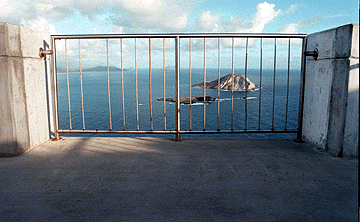
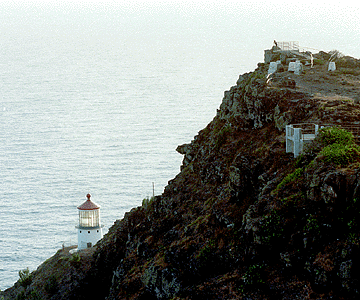
'Gated' lookout points allow a grand view from above the Makapuu lighthouse.
Cliffside concrete bunkers bring to the imagination nervous GIs, author James Jones and his fellow soldiers anxiously scanning the horizon for the Japanese invasion fleet that they were sure would sail into sight any day and finish what they started at Pearl Harbor.
Past the summit, there are foundations of buildings that housed Coast Guard members who tended the Makapuu Lighthouse, buildings later occupied by Bumpy Kanahele and his followers until police surprised them before dawn and carted them off to jail.
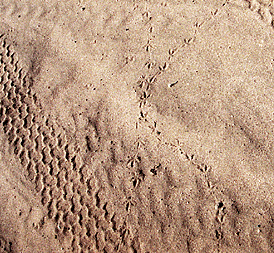
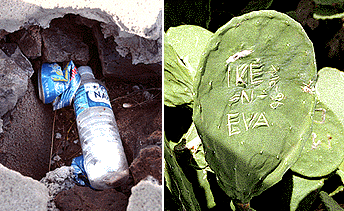
Man and nature cross paths as evidenced by trash wedged between rock crevices, tracks in the sand and a cactus plant carved with names.
Seabirds ride the air currents effortlessly they commute to a long day of fishing while along nearby Kalanianaole Highway a steady stream of cars carries workers toward town.
At the highest part of the cliff, the illusion of solitude - already tarnished by the highway - is further eroded as the elevation displays the hundreds of houses crawling up Kamehame Ridge. The cluster extends all the way to the distant Black Point at the foot of Diamond Head.
Daniel Kim regularly makes the climb to the lookout before dawn with his wife and dogs to greet the sunrise and meditate. The Kahala dive instructor was dismayed to learn of plans to fill the valley and ridges with houses, a hotel and a golf course. "They would take away the last special place in the area."
The descent from the cliffs leads into Kealakipapa Valley with it's austere simplicity usually found in deserts. But the little movements, little tracks, the drift of the clouds and the blowing of the wind catch the attention.

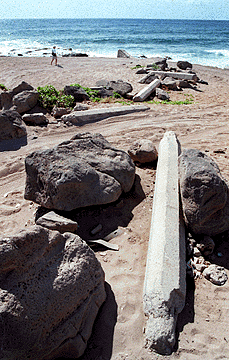 Concrete piles, left, and derelict cars mar what would otherwise be a pristine landscape.
Concrete piles, left, and derelict cars mar what would otherwise be a pristine landscape.It's a rugged environment where hardy succulents cling to the rocky soil and shrug off the relentless salt spray. Beach naupaka provides a dash of color with their green leaves and white berries. Kiawe and haole koa trees add more greenery in the sun-seared landscape, and the sight of the plants and animals struggling to live in the harsh environment gives a new appreciation for the tenacity of life.
It wasn't always this way. Kealakipapa Valley was once the site of an ancient Hawaiian village called Wawamalu, which means shady valley. It was famous for growing yams and sweet potatoes to provision whaling ships.
Corporate official Alan Sanford Davis, a head trustee of Campbell Estate, built a beautiful home and in the valley and called it Wawamalu Ranch. But on April 1, 1946 a tsunami raged through the valley and waves ripped away the ranch and scattered pieces as far away as Hanauma Bay and Kalama Valley.
The tsunami also left boulders in the valley and coated it with salt, leaving it barren.
But there are also unique native and endangered species here, archaeological sites of cultural significance, including the old king's highway, and sites known to Hawaiian legend.
The walk along the rutted dirt road toward Queen's Beach belie evidence of humanity. Corpses of cars riddled with bullets quietly bleed rust. An incredible amount of rubbish is tossed about: shoes, clothes, huge nylon fishing nets and gear, glasses and cups, nylon nets, a whole oven and the hand cart that was used to carry it.
At times on the weekend, the solitude is shattered by off-road vehicles and dirt bikes roaring around, tearing up plants and digging ruts, sneaking by the barriers the landlord has erected.
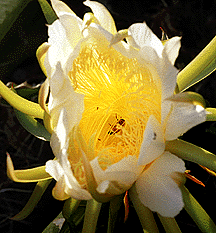
Tenacious flowers survive and dot the craggly landscape.
The giant pohaku (stone), high on the cliff that guards the beginning of Makapuu Point, has been tagged by teen-agers to immortalize their fleeting romances or proclaim 'Yes, I am somebody!'At the end of the long dirt road is a little bay, a sheltered cove where the sand has more bird tracks than human footprints. Once again traffic noisy is buffered by the roar of waves as they smash ashore, covering the black lava rocks briefly in white.
Here, the tension of city life evaporates, and lines of worry ease from the face. You can breathe deeply and pause to ponder the world around you, to enjoy a sublime sense of solitude, see things you've never noticed before.

Salt from a tsunami's waters years ago has made this portion barren although there is some greenery.
Nearby, mangrove trees line the shore of the estuary that separates the two sides Queen's Beach. As you walk through, you have the feeling that at any moment an alligator might lunge out of the shallows.
At the old Wawamalu Bridge, look one way and you see the magnificent sweep of the cliffs at Makapuu, look the other and you see the artificially landscaped and watered golf course and golfers happily putting away.
Look again and there is the bulwark of the backside of Koko Crater; turn your head the other way and the ocean awaits.
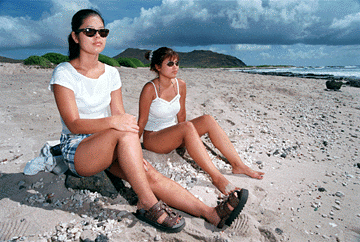
Sisters Lisa Ichioka, 25, and Cindy, 20, right, Florida residents formerly of Kailua, have fond memories of Wawamalu Beach. Their father often took them there when they were children.
A miniature blowhole erupts and spews sea spray into the air with each wave, an attraction most tourists and residents never see.
Cindy and Lisa Ichioka are among the few who do. When they returned to visit Hawaii from their new home in Florida they head straight for Wawamalu Beach. In small-kid times, their father use to bring them them to Wawamalu to play.
They return to Wawamalu because it's the only place on Oahu that hasn't changed over the years. So the young sisters are horrified to learn that change threatens the valley and ridges with a proposed golf course, homes, hotel and industrial complex.
"We don't need any more golf courses," Cindy says indignantly. "There are so few untouched places. There is no traffic, no tourists, no tall highrises."
"This is why we came here," her sister adds quietly.
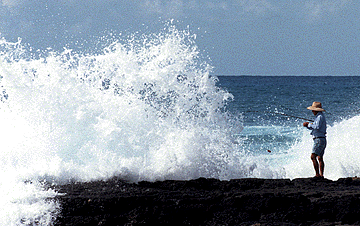
Wawamalu Beach has long been a favorite fishing spot for Richard Tamaoka, above, and his brother Kelly. "Too much city, not enough Hawaii," said Kelly, when told of the proposed development. "There is no place else to go" said Richard. "This is the last frontier."
It has been their favorite spot for decades. They, too, are aghast when told of the proposed development for the area.
"That will be the end for us," says Richard. "There is no place else to go.
"Too much city, not enough Hawaii," says Kelly.
Says Richard, "This is the last frontier."